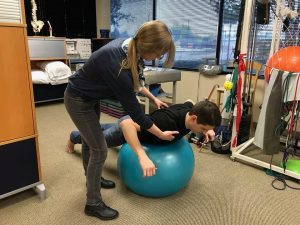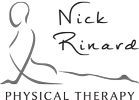We can get you back to walking, exercising, running, enjoying your sport again….
“I had horrible knee pain that was keeping me from being a mobile as I wanted.
Even just going up and downstairs even hurt.
Dr. Rinard was amazing- best PT experience I’ve ever had.
Exercises were easy to do + only had once/week appointments after the first week.
I can no go down stairs with no pain, one legged lunges without pain, play tennis without pain, + do 5K walks or more without knee pain.
THANK YOU ALL!”
Marla
More
Nick Rinard Physical Therapy has continued SAFETY MEASURES and are ALWAYS here for you!
Our staff is fully vaccinated and continues to follow social distancing, sanitation protocols and wear masks.
New patients and established patients will find every visit very valuable and should not delay care due to increases in Coronavirus cases.
We are here to diagnose, educate, offer tools, listen to concerns, and meet all safety needs of every patient.
May all our patients stay safe, healthy and have a quick recovery should they test positive for Coronavirus this summer.
Nick Rinard Physical Therapy is here for you.
More
It has been a busy and wonderful spring at Nick Rinard Physical Therapy!
We are excited about getting you pain free from all your injuries so that you can slide into your favorite summer activities!
While a lot of injuries can occur during activities, it’s just as common to injure yourself slouching on the couch with your feet up while you have been waiting for the rain to stop and the sun to shine.
Your seasonal pains could point to a chronic condition that could easily be treated.
With summer just around the corner take care of your aches and pains now before they get worse.
Nick Rinard Physical Therapy is ALWAYS here to help!
More
We, at Nick Rinard Physical Therapy, hope that everyone had a great holiday.
After Thanksgiving the end of the year seems to go by a little faster than usual.
You have lots to do and you don’t need to do it in pain.
Get your results today!
“Lumbar pain – was a deranged disc.
Katie fixed me right up in a couple of weeks.
And now my range of motion is better than before the injury.
Resuming running / yoga….”
Andrew
More
‘Tis the season for making resolutions, focusing on self-improvement, and charting the course for the year ahead. What are you doing to improve yourself in 2018? One small step that can make a tremendous impact in many areas of your life is simply to establish good self-accountability. How credible are you? Many of us are loyal to commitments we make to our friends, family, and coworkers but we may routinely neglect to fulfill our promises to ourselves. When was the last time you put off a work out, failed to follow through with a diet goal, or simply lost momentum with a good training program?
Creating the discipline of good habits is beneficial to all of us! Whether you are looking to reboot your home exercise routine or seeking to redeem your diet after an avalanche of holiday feasts – consistency is the key. Daily diligence defines the difference between crashing through a fad and building a foundation of good habits that can improve your life. In some areas of life, this need for consistency is obvious, for example: brushing your teeth. If you wish to have fresh breath for your date on Friday night, is brushing your teeth just once on Tuesday going to cut it? Nope! Good oral hygiene requires that twice a day commitment every day of the week. Other areas of our health will benefit from applying this daily discipline as well.
So, here are 5 easy ways to help build credibility with yourself and to insure you follow through with all of those good intensions.
- Make an appointment with yourself – Schedule time on your calendar each day, even if it is just 20 minutes, to do your home exercise program. Honor this time the same way you would honor any other medical appointment.
- Reward yourself when you follow through – Improving your health is its own reward, but you may need other tangible incentives to keep you motivated on your course. Make a barter system with yourself – “For every 10 minutes I spend on this treadmill, I will get 10 minutes of guilt-free Netflix ve
- Get friends and family onboard – One of my patients found the best way to correct his posture was to recruit his children, “It’s open season, kids – anytime you can catch me slouching, call me on it and I will give you a dollar.”
- Keep it visible – Put those running shoes in a high visibility area of your home so that you have a visual reminder to gear up and get outside for a jog. Are you using a theraband for your exercise routine? Don’t hide it – hang it in plain sight so that you are prompted to put it to good use!
- Teach what you’ve learned – If you have mastered a new exercise or healthy recipe, share it! Pay it forward and reap the benefit of better understanding through teaching. You know you have truly mastered a technique when you can teach it effectively to someone else.
So let me know – what do you do to encourage yourself to follow through with your commitments to yourself? Have you tried any of these suggestions before? Do you have new ideas you’d like to share with us? Let’s support each other in making 2018 a year of abundant good health!
More
BACKGROUND:
Up to 80% of the population will experience low back pain (LBP) at some point in their adult life (Croft et al 1997). It is estimated that health care costs for low back pain are larger than for any other disease for which economic analysis is available (Maniadakis and Gray 2000) ($31 billion/year). There is little to no evidence supporting the use of traction, thermal modalities, or electrical stimulation for the treatment of LBP. Unfortunately, these strategies are commonly used for the bulk of LBP treatment. Many studies conclude that the McKenzie method of evaluation and treatment for LBP is superior to that of standard treatment (general stretching and strengthening). What makes the McKenzie approach different is its classification system. Based off of symptom response to repeated lumbar spine movements, patients are classified into 1 of 3 syndromes (derangement, dysfunction, postural). After patients have been classified, their individualized treatment plan is created. The McKenzie method also emphasizes self-treatment and long term symptom management. I consider this the most valued aspect of treatment, as statistics show LBP is recurring in nature. Let’s review a case of a patient with a very successful outcome utilizing the McKenzie method.
SYMPTOMS:
Patient presented to therapy 2 weeks after the onset of LBP with bilateral leg pain. Patient described sharp pain which radiated down to the left foot and down to the right shin. Symptoms started after a weekend of working (auto mechanic) which involved repetitive bending and lifting of heavy equipment. Patient rated worst pain as an 11/10 for the back and a 10/10 for the left leg, occurring on a daily basis. Patient was severely limited with walking, sitting and sleep.
THERAPIST’S EVALUATION AND FINDINGS:
Patient demonstrated pain with all lumbar spine motions in standing. There was no neurological (strength, sensory, reflex, neural tension) deficit. This is important to test when there is a presence of leg pain.
Baseline symptoms= LBP + left foot tingling. Patient was asked to bend forward 10 times, touching his toes. This resulted in increased low back pain, no effect on foot tingling. Bending backwards 10 times also increased LBP with no effect on foot tingling. Patient was then asked to lie on his stomach and perform prone press ups (a back bend using arms to push up into extension). This exercise abolished left foot symptoms, better leaving the clinic that day.
PATIENT HOMEWORK AND OUTCOMES:
Patient was given prone press-ups to be done every hour until his follow up appointment. The next day, the patient returned to the clinic happily reporting that he had not experienced leg pain in over 24 hours! The patient was even able to perform tasks associated with moving into his new home that weekend. In 2 weeks his back pain rating had decreased to a 3/10 and he was experiencing little to no leg symptoms! Patient continued therapy over the next few months with exercise progressions and modifications as needed. At discharge, patient was able to perform his duties as an auto mechanic and continue his training as a member of the National Guard.
HAVE A MECHANICAL EVALUATION FOR YOUR LOW BACK PAIN:
Do not fall victim to chronic low back pain. This is associated with huge healthcare costs, over utilization of medication and surgery. All of which would otherwise be avoided with a simple exercise, requiring no special equipment. The patient from this week’s case left the clinic feeling very empowered by his own ability to treat his symptoms and was no longer considering having major spine surgery.
More

